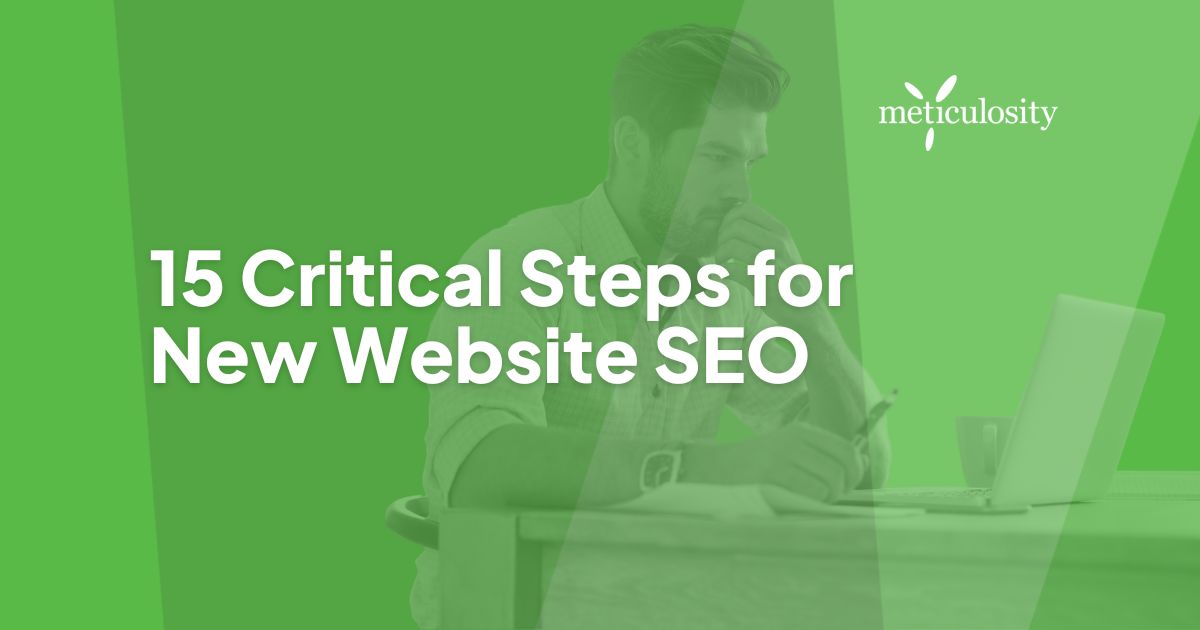While you can make some adjustments to SEO after the fact, you’ll be much better off if you make a few considerations when developing your new website plan.
Why is SEO So Important for a New Website?
SEO is important to the success of a website, but are you digging deep enough with your strategy? By applying an SEO checklist to every page of your site—not just the home page—you’ll ensure that the right traffic reaches each layer of your message. Here is how to optimize for SEO, draw readers to your site, and keep them there.
SEO Tips for New Website
1. Communicate your Value Proposition
Once you know your organization’s mission and what you want to accomplish, the challenge is to convey your value proposition so that potential customers find it when they search.
Conversely, if you are solving a unique problem, or your solution isn’t found with common search terms, look for alternative search terms for your product or service that are more likely to show up in a search.
2. Know your Competition
One of the easiest and smartest steps you can take before you begin your website design is to scour the internet for information about your competitors. Find out how they rank. Know what search terms they are using.
Pretend you are a consumer and fake search for products and services to find potential keyword and SEO advantages you might have over your competition.
3. Understand your Customers
To build a strong SEO strategy, you must understand your customers and the market segment in which you compete. Which buyer personas are you targeting? How big is your online audience? Where do they go for information?
By finding the answers to these and similar questions before you begin your design, you’ll save yourself and your customers a lot of frustration by expertly mapping your keywords to your market.
4. Get Technical
Once you understand your customers, mission, and competitors, and you’re ready to build your site, take into account the specific technical requirements expected by your audience. Many standard technical aspects are considered to be your website's building blocks.
Today's standards include HTTPS for a secure site, responsive design for mobile devices, and blazing-fast web hosting. Keep your website design and infrastructure nimble while making sure your code and framework help improve site speed.
If your audience is global, consider localizing your content. Know what you need to do in advance to set yourself up for SEO success and minimal re-work.
5. Build for Content
What types of content are you most likely to post on your website? It's really important that your new website theme allows you to manage all content types responsively.
Whether it is videos, white papers, infographics, or blog posts, make sure your website infrastructure supports it, and the functionality is reliable and easy to manage.
6. Keep the Crawlers Happy
If search engine crawlers have a difficult time crawling your content, you may never get indexed, which will doom your search rankings to failure.
Create a good internal link structure so Google can easily crawl your site. This means building your site so that it requires only a few clicks to access the depths of your content. It also means linking core and subtopic pages of related content to show Google the internal relationship.
Use visual analytics, such as heat maps, to understand how users are using and navigating your content. Heat maps show how users move, click, and scroll. Hotjar is a great tool for this.
/Imported_Blog_Media/SEO-Website-Design-3-750x452-4.jpg?width=750&height=452&name=SEO-Website-Design-3-750x452-4.jpg)
7. Schema is your Friend
By using structured data, no matter what program or search engine is crawling your site for information, you’ll have fewer “bad page” returns and better readability. Structured data will help the web crawlers understand your content better.
8. Be Mobile Responsive
In our digital age, we expect websites to be responsive. The experience should be similar on a laptop, tablet, or smartphone. Keep your website design flexible and responsive to a variety of devices, and leave room in your design for the future—you never know what’s coming next!
theme developers bake responsiveness into their website design themes so you don't have to. Whichever CMS you use, thoroughly review its capabilities; some are better than others. This should also be a part of your “pre-design work” strategy to set your website up for success and save yourself headaches afterward!
9. Be Consistent
Just as crucial to having a unified voice and tone throughout your website, is having a consistent look and feel to your pages. The design, color scheme, and structure should feel like an extension of your home page and your brand.
Web crawlers pick up on design elements and will automatically connect additional content to your existing pages if they see consistency.
10. Link to Your Own Stuff
When you create a new page, don’t forget to include links and resources to recirculate traffic.
Make it easy to navigate back to your homepage. It will make it easier for bots to connect your content to an already-ranked page and help your readers quickly find the content they need.
11. Be Fast to Load
As part of your SEO checklist, watch out for large (non-optimized) images, external scripts, and bulky plugins with high loading overhead. If your load times are slow, you'll use your entire crawl budget with the search engine crawlers.
Keep it simple, and don’t forget to test every page, checking for fast load times.
Check your website speed at GTMetrix
12. Keep it Fresh
Don’t fill your pages just to fill them. Make sure each page has fresh new content that serves a specific purpose.
Be sure you're following good content marketing practices. The bots reward highly authoritative, long-form, well-researched content and resonate well with an audience.
13. Use the Right Keywords
Use a mixture of keywords throughout your copy. Don’t lump them all in one section; spread them throughout the body of your paragraphs, title headers, sub-headers, and meta tags - especially the title tag and meta description. You can even use keywords in the alt and title of your images for a little extra SEO punch.
14. Use Good URL Structure
Be strategic when you create URLs and use your keywords - but don't overdo it. Finding the right pages will be simpler for your audience, and the web crawlers will reward you for it.
Don't use special characters to separate words in your page or post URL except for a dash," -. "
15. Make New Friends
One of the best ways to boost SEO for a new website is to use external links to other thought leaders of complementary content to your own. You might even get a reciprocal like from the page, and their readers and rankings will boost your SEO and web traffic efforts. If you aren’t getting linked in return, don’t be afraid to ask!
Get your website ranking in search. Get your Website SEO Audit now.
Over to you
Check your results after you create each new page. If the page isn’t performing as well as it should, go through your SEO checklist and see what you can tweak. Is it slow upload time? The wrong keywords? A poor URL?
Course correct as needed to ensure the best results for each page. These tips aren’t just for a new website.
It’s smart to revisit your content once in a while to ensure your SEO strategy is still going strong. A boost in rankings is sure to follow.







